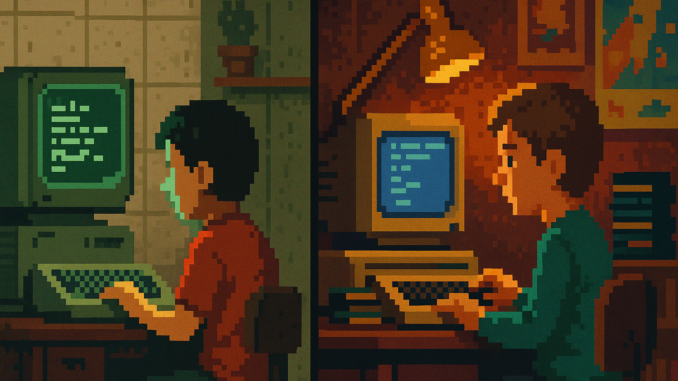
This is Part 3 of our ongoing series “Around the World in 8 Bits,” where we explore how home computing took root across the globe — not just in Silicon Valley or suburban Britain. If you missed the last instalment, check out “Part 2: Silicon Shōtengai – Japan’s 8-Bit Computing Revolution”
Prologue: Blinking Cursors, Divided Dreams
In the winter of 1985, two flickering screens lit up across a divided Germany. In Leipzig, a KC 85/3 hummed to life in a tiled-panel flat, its green phosphor glow casting shadows on a boy’s bunk bed. In Ludwigshafen, a Commodore 64 whirred beside a stereo stack, waiting for Giana Sisters to load from tape. Different systems, different worlds — and yet both scenes shared one thing: a teenager leaning forward, fingers ready at the keys, hearts full of code and imagination.
That was the magic of the 8-bit era in Germany: one language, spoken on both sides of the Wall.
West Germany: Catalogues, Commodores, and Clubs
In the Federal Republic, the 1980s home computing boom arrived with glossy pages and mail-order boxes. Quelle and Kaufhof catalogues featured lovingly photographed machines — the Schneider CPC 464 (Amstrad’s local incarnation), Commodore 64s, Atari 800XLs. They seemed like objects from the future. For many kids, the first unboxing wasn’t in-store, but at the family dinner table after a trip to the post depot.
Tech magazines like 64’er and Happy Computer weren’t just sources of news — they were Bibles. They taught a generation to code, to solder, to tweak the SID chip for homemade tunes. Clubs popped up in church halls and youth centres, where kids demoed scrolltext intros and traded copied games on Maxell tapes.
In back rooms above bakeries or tucked into university labs, Germany’s demoscene began to take form. Not as rebellion, but as digital craft. Crunched code and raster bars were passed from Karlsruhe to Kiel with reverent urgency.
East Germany: Silicon Behind the Curtain
On the other side of the Iron Curtain, computing took root not through commerce, but curriculum. The GDR’s educational push birthed the KC 85 series (based on the U880 processor, a Zilog Z80 clone, with 16KB to 64KB of RAM depending on the model) and the Z1013 DIY computer kit (featuring a 2.5MHz U880 CPU and just 1KB of onboard RAM expandable to 32KB) — machines shaped by scarcity, built for resilience. The parts were few, the interfaces bare. But the will to create? Boundless.
In schools and youth clubs, kids learned BASIC under the gaze of portraits of Marx and Engels. Yet even in this setting, creativity crept in. Programs designed to simulate physics experiments morphed into text adventures. Cassette drives copied Western games, tweaked and trimmed to run on limited memory. Enthusiasts beamed code over radio frequencies for home capture — a broadcast of resistance in binary.
There were whispers of Western hardware: smuggled ZX Spectrum boards, black market listings scribbled on scrap paper, copies of Happy Computer passed hand to hand like contraband. And notably, girls were encouraged in computing clubs as part of broader gender equality policies — a detail often forgotten in Western retellings.
Reunification: Code Meets Culture
Then came 1989.
The Wall fell. And with it, so did the firewalls around computing culture. Commodore 64s, Amigas, and IBM compatibles flooded into East Berlin shops — machines that boasted vastly superior graphics, multichannel audio, and broader software libraries compared to the modest KC units. Suddenly, KC machines felt old overnight. Kids scrambled to trade their machines, or simply abandoned them. But some kept them, quietly aware that these weren’t just computers — they were time capsules.
For many teens from both sides, this was a surreal moment: two dialects of the same language, finally meeting. BASIC ran on both systems, but paths diverged — memory addresses, character sets, tape formats. Debugging across that divide required more than technical knowledge. It required empathy.
KC Reborn: A Revival in Bits and Bytes
Today, the KC 85 isn’t forgotten. It’s on display at museums in Dresden and Berlin, with detailed panels explaining its quirks and limitations. Online, emulators like KCemu, first released in 2002 and actively maintained by a small team of German preservationists, recreates the experience for those too young to remember. Retro computing groups across Germany — including the Robotrontechnik community and the Digital Retro Park — have begun archiving East German software, translating it, restoring it.
Artists and designers have even embraced the aesthetic: low-res character graphics, amber-toned displays, and the minimalistic UX of the Bloc. Some call it “Communist pixel chic.” Others call it respect.
The revival isn’t just about hardware. It’s about remembering that innovation thrives in constraint. That limitations often lead to the most poetic code.
Conclusion: Memory as Software
Germany’s computing past isn’t just a story of division — it’s a story of convergence. Two very different systems taught their youth to think in code, to build with what they had, to imagine worlds beyond their borders.
Today, whether it’s through a lovingly restored KC motherboard or a glitchy demoscene remix, the legacy lives on. And in every blinking cursor, on every restored machine, you can still see the same spark.


Leave a Reply